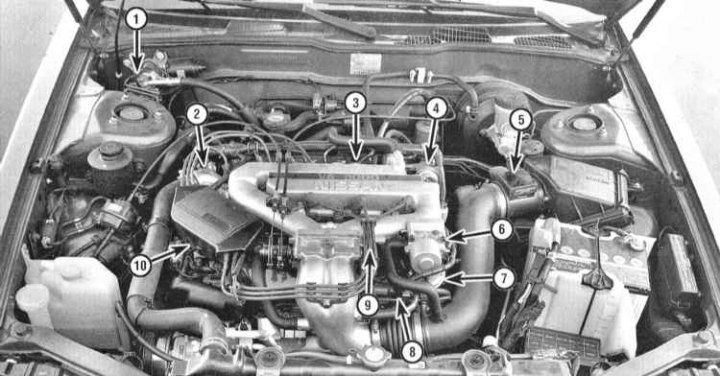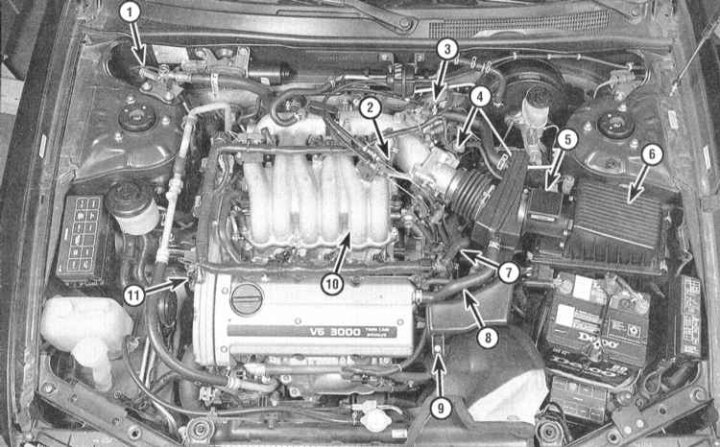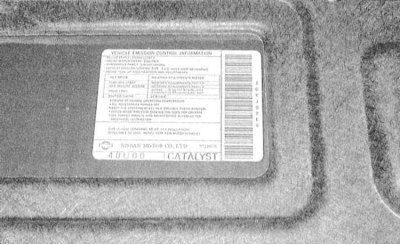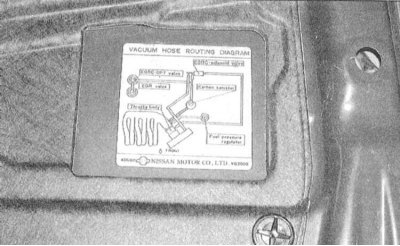The layout of the components of the engine management / reduction of toxicity of exhaust gases in the engine compartment of the 1993 and 1994 models. issue

1 - Sensor-switch PAS; 2 - Engine coolant temperature sensor; 3 - PCV valve; 4 - Power valve actuator; 5 - MAF sensor; 6 - IAC valve; 7 - EGR valve; 8 - Knock sensor (under the exhaust manifold); 9 - TPS; 10 - Camshaft position sensor (in the ignition distributor)
The layout of the components of engine management systems / reducing the toxicity of exhaust gases in the engine compartment of models since 1995, vol.

1 - Sensor-switch PAS; 2 - valve PCV; 3 - Electromagnets for controlling the speed of fast idle and the IAC valve; 4 - PS; 5 - MAF sensor; 6 - Intake air temperature sensor; 7 - EGR and EVAP solenoid valves; 8 - Engine coolant temperature sensor; 9 - Location of the MAP sensor; 10 - Knock sensor (under intake manifold); 11 - Camshaft position sensor (in the ignition distributor)
In order to reduce the level of emissions into the atmosphere of toxic components that enter the composition of the exhaust gases of the engine as a result of evaporation and incomplete combustion of fuel, as well as to maintain engine efficiency and reduce fuel consumption, the vehicles covered in this Guide are equipped with a number of special systems that can be would unite under the general name of engine management systems and reduce the toxicity of exhaust gases.
Systems related to engine management and emission control include the following:
- a) Electronic engine control system;
- b) Evaporative Emission System (EVAP);
- c) Controlled crankcase ventilation system (PCV);
- d) Exhaust gas recirculation system (EGR);
- e) catalytic converter.
The functioning of all these systems, one way or another, directly or indirectly, is related to the management of the reduction of exhaust gas toxicity. The following Sections provide general descriptions of how each system operates, as well as procedures for diagnostic checks and remedial repairs (if it is possible) individual components, the performance of which lies within the qualifications of the average amateur mechanic.
Before coming to the conclusion that any of the emission control systems have failed, carefully check the power and ignition systems for proper functioning (see chapters Power and exhaust systems and Engine electrical equipment). Diagnostics of some of the components of toxicity reduction systems requires the use of special, difficult-to-use equipment and a certain qualification of the performer, and therefore, it would be reasonable to entrust its implementation to professional mechanics of a specialized service station.
The foregoing does not mean that the maintenance and repair of components of toxicity reduction systems in practice seem difficult. Do not forget that one of the most common causes of failures is an elementary violation of the quality of vacuum or electrical connections, and therefore, first of all, you should always check the condition of the fittings and electrical connectors. The owner of the car can independently and quite easily perform a number of checks, as well as perform many routine maintenance procedures for most system components at home, using the usual set of tuning and locksmith tools.
Note. Be aware of additional federal warranties that apply to emission control and engine management components. Before starting any repair procedures for components and parts of these systems, consult the conditions for compliance with these obligations at the representative office of Nissan.
Try to observe all the precautions specified in the following Sections when performing maintenance of the electronic components of the systems in question. It should be noted that the illustrative material may not always exactly match the actual placement of components on the vehicle. Such inconsistencies are associated with the ongoing process of modification within the framework of the typical design of each model.
An information label of exhaust gas toxicity reduction systems is fixed in the engine compartment of the car (VECI). The label contains the necessary information on the settings and checks of controlled systems, taking into account all modifications made to a particular vehicle, as well as a diagram of the laying of vacuum hoses with the identification of various components. Read the VECI data carefully before servicing the emission control and engine management systems.
Note. The hose routing diagram can be shown on a separate nameplate.
 |  |